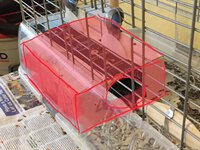Shanti_P
Moving in
- Joined
- 4/5/21
- Messages
- 7
I have had 2 cockatiels, a male and a female, for over 6 years. We got a male first and then when we got a female, she was already pregnant and laid an egg but it dropped to the bottom of the cage. For around 4 years, she has started mating with our male cockatiel but they have never had babies. Around 2 years ago, they had started roaming around the room and found cardboard in a dark corner and started chewing it up and hiding in there. I added a nesting box in order to prevent her laying and egg on a perch but they went in and out and never laid an egg.
A few days ago, I found them behind the couch chewing up cardboard, so I added a nesting box in their cage. Since they had been trying for several years I did not expect them to lay an egg, I had made a nesting box from a 12 by 10 by 5 box (which is really short) and added some carboard for them to chew on. Yesterday, I had found out she laid an egg, but I know the box doesn't have the proper bedding, height, and has large pieces of carboard inside. I want to change the nesting box to a more suitable one, but I am unsure what problems this would pose to the cockatiels. I tried to do as much research as I can but was unable to find reliable information on this topic. I was hoping to get some advice on here!
Some other information about my cockatiels is that they are mainly on a seed diet but get carrots everyday and occasionally get apples. They live in one cage with 2 presumably female budgies, and have been doing so since 5 years ago. The cage is around approximately 12 by 24 and 36 inches in height, but we leave the cage open at all times to have access to the house. The age of the cockatiels are both unknown.
Their very DIY nest box:

A few days ago, I found them behind the couch chewing up cardboard, so I added a nesting box in their cage. Since they had been trying for several years I did not expect them to lay an egg, I had made a nesting box from a 12 by 10 by 5 box (which is really short) and added some carboard for them to chew on. Yesterday, I had found out she laid an egg, but I know the box doesn't have the proper bedding, height, and has large pieces of carboard inside. I want to change the nesting box to a more suitable one, but I am unsure what problems this would pose to the cockatiels. I tried to do as much research as I can but was unable to find reliable information on this topic. I was hoping to get some advice on here!
Some other information about my cockatiels is that they are mainly on a seed diet but get carrots everyday and occasionally get apples. They live in one cage with 2 presumably female budgies, and have been doing so since 5 years ago. The cage is around approximately 12 by 24 and 36 inches in height, but we leave the cage open at all times to have access to the house. The age of the cockatiels are both unknown.
Their very DIY nest box:


